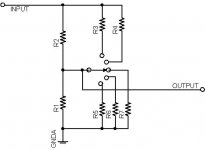If we label the three connections on the attenuator input, wiper and common, then this is a resistor from common to ground? But this would prevent the attenuator from shorting out to ground, i.e. going completely off?
I can see two scenarios here
a) conventional SE attenuator as above
b) shunt attenuator in balanced mode, which is just a single series of steps between plus and minus
Is either of these easier to achieve? In the latter, with no resistor in circuit it would be open circuit i.e. max volume.
I can see two scenarios here
a) conventional SE attenuator as above
b) shunt attenuator in balanced mode, which is just a single series of steps between plus and minus
Is either of these easier to achieve? In the latter, with no resistor in circuit it would be open circuit i.e. max volume.
No it wouldn't prevent the attenuator from going all the way to ground. It is in parallel with the attenuator output.
Incidentally this resistor should be as high as you can safely make it to avoid loading the attenuator. Say in the case of a 100K to 250K attenuator something like 1M ohm.. (Depends also on the safe maximum grid resistance for the input tube you are using.)
Incidentally this resistor should be as high as you can safely make it to avoid loading the attenuator. Say in the case of a 100K to 250K attenuator something like 1M ohm.. (Depends also on the safe maximum grid resistance for the input tube you are using.)
If you build an attenuator as shown in the drawing there will be no clicks or pops if a break before make switch is used.
The example has only a few steps to illustrate the concept. I've built one with 1 dB steps and I would probably go with 1.5 dB steps if I did it again.
Of course not all the steps have to be the same size, near the bottom I made each step bigger so my last step was 10dB (40 dB total attenuation)
The example has only a few steps to illustrate the concept. I've built one with 1 dB steps and I would probably go with 1.5 dB steps if I did it again.
Of course not all the steps have to be the same size, near the bottom I made each step bigger so my last step was 10dB (40 dB total attenuation)
Attachments
- Status
- This old topic is closed. If you want to reopen this topic, contact a moderator using the "Report Post" button.
- Home
- Amplifiers
- Tubes / Valves
- Stepped attenuators - break before make?
